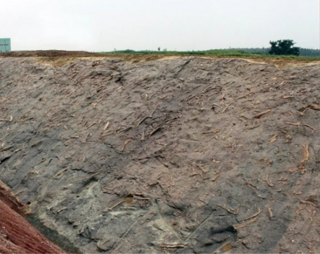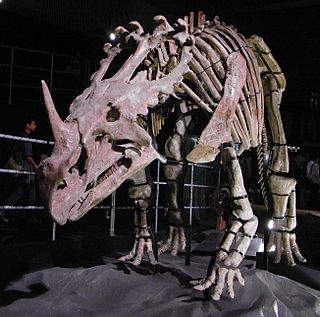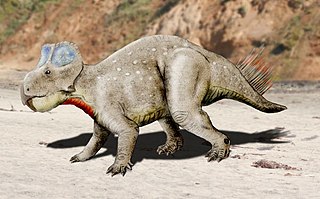
Theropoda, whose members are known as theropods, is a dinosaur clade that is characterized by hollow bones and three toes and claws on each limb. Theropods are generally classed as a group of saurischian dinosaurs. They were ancestrally carnivorous, although a number of theropod groups evolved to become herbivores and omnivores. Theropods first appeared during the Carnian age of the late Triassic period 231.4 million years ago (Ma) and included the majority of large terrestrial carnivores from the Early Jurassic until at least the close of the Cretaceous, about 66 Ma. In the Jurassic, birds evolved from small specialized coelurosaurian theropods, and are today represented by about 10,500 living species.

Giganotosaurus is a genus of theropod dinosaur that lived in what is now Argentina, during the early Cenomanian age of the Late Cretaceous period, approximately 99.6 to 95 million years ago. The holotype specimen was discovered in the Candeleros Formation of Patagonia in 1993 and is almost 70% complete. The animal was named Giganotosaurus carolinii in 1995; the genus name translates to "giant southern lizard", and the specific name honors the discoverer, Ruben Carolini. A dentary bone, a tooth, and some tracks, discovered before the holotype, were later assigned to this animal. The genus attracted much interest and became part of a scientific debate about the maximum sizes of theropod dinosaurs.

Shantungosaurus is a genus of very large saurolophine hadrosaurid dinosaur found in the Late Cretaceous Wangshi Group of the Shandong Peninsula in China, containing a single species, Shantungosaurus giganteus. The stratigraphic interval of Shantungosaurus ranges from the top of the Xingezhuang Formation to the middle of the Hongtuya Formation, middle to late Campanian in age. Shantungosaurus is so far the largest hadrosauroid taxon in the world, with size estimates around 15–17 metres (49–56 ft) in length and 13–16 metric tons in body mass.
Chingkankousaurus is a genus of theropod dinosaur containing the single species Chingkankousaurus fragilis. C. fragilis is known only from a single fossilized bone fragment from the late Cretaceous Period Wangshi Series of Shandong province in eastern China.
Phaedrolosaurus is a genus of theropod dinosaur, based on a single tooth possibly from the Valanginian-Albian-age Lower Cretaceous Lianmugin Formation of Wuerho, Xinjiang, China.

Pukyongosaurus is a genus of titanosauriform dinosaur that lived in South Korea during the Early Cretaceous period. It may have been closely related to Euhelopus, and is known from a series of vertebrae in the neck and back. The characteristics that were originally used to distinguish this genus have been criticized as being either widespread or too poorly preserved to evaluate, rendering the genus an indeterminate nomen dubium among titanosauriforms. The 2022 study noted that Pukyongosaurus is probably a somphospondylan.

Zhucheng is a county-level city in the southeast of Shandong province, People's Republic of China. It is under the administration of Weifang city and had at the 2010 census a population of 1,086,222 even though its built-up area is much smaller.

Luanchuanraptor is a genus of dromaeosaurid theropod dinosaurs from the Late Cretaceous of China. The genus is based on a partial skeleton from the Qiupa Formation in Luanchuan, Henan. They were medium-sized dromaeosaurids, the first Asian dromaeosaurid taxa described from outside the Gobi Desert or northeastern China.

The Wangshi Group is a geological Group in Shandong, China whose strata date back to the Coniacian to Campanian stages of the Late Cretaceous. Dinosaur remains are among the fossils that have been recovered from the group.
Amblydactylus is an ichnogenus that has been attributed to dinosaurs. The generic name, derived from the Greek words amblys and dáktylos, means "dull finger". Two species of Amlydactylus have been named: A. gethingi, which references the Gething Formation where it was found; and A. kortmeyeri, which honours Carl Kortmeyer who discovered the holotype.

Sinoceratops is an extinct genus of ceratopsian dinosaur that lived approximately 73 million years ago during the latter part of the Cretaceous Period in what is now Shandong province in China. It was named in 2010 by Xu Xing et al. for three skulls from Zhucheng, China. The name of its type species Sinoceratops zhuchengensis means "Chinese horned face from Zhucheng", after the location of its discovery.

Zhuchengceratops is a genus of extinct leptoceratopsid ceratopsian that lived during the Upper Cretaceous of modern-day China. It was first described in 2010, by Xu et al., who created the binomial Zhuchengceratops inexpectus. The name is derived from the location of Zhucheng, the Latinized-Greek ceratops, or "horned face", and the unexpected articulated nature of the holotype. The skeleton was found in the Wangshi Group, which is of Late Cretaceous age, and most fossils are only disarticulated bones of Shantungosaurus.

Zhuchengtyrannus is a genus of tyrannosaurid theropod dinosaur known from the Campanian stage of the Late Cretaceous of Shandong Province, China. It belongs to the subfamily Tyrannosaurinae, and contains a single species, Zhuchengtyrannus magnus.
The Xingezhuang Formation is an Upper Cretaceous fossil bearing rock formation in China. It is located near Zhucheng, in the province of Shandong.

Ischioceratops is an extinct genus of small herbivorous ceratopsian dinosaur that lived approximately 69 million years ago during the latter part of the Cretaceous Period in what is now China.
Zhuchengtitan is a genus of titanosaurian sauropod dinosaur from the Late Cretaceous of Shandong, China. It contains a single species, Z. zangjiazhuangensis, named by Mo Jinyou and colleagues in 2017 from a single humerus. Zhuchengtitan can be identified by the extreme width of the top end of its humerus, as well as the expansion of the deltopectoral crest on its humerus; both of these characteristics indicate that it was likely closely related to Opisthocoelicaudia. However, it differs from the latter by the flatter bottom articulating surface of its humerus. Zhuchengtitan lived in a floodplain environment alongside Shantungosaurus, Zhuchengtyrannus, and Sinoceratops.

Anomalipes zhaoi is an extinct caenagnathid dinosaur discovered in China. It lived during the Campanian-aged Wangshi Group in China. It is the only species in the genus Anomalipes.
Sinankylosaurus is a genus of dinosaur, originally described as an ankylosaur, from the Late Cretaceous Hongtuya Formation of Shandong, China. The genus contains a single species, Sinankylosaurus zhuchengensis, known from a nearly complete right ilium. The describers claim that the discovery of Sinankylosaurus further demonstrates the similarity between dinosaurs of eastern Asia and western North America.











